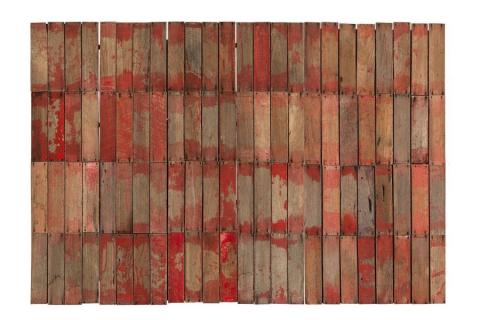ROSE RED CITY 4, 1991-93
ROSALIE GASCOIGNE
painted and sawn timber on composition board
diptych: 123.5 x 179.5 cm (overall)
panel one: signed, dated and inscribed verso: Rose Red City / Rosalie Gascoigne / 1991–93
panel two: signed, dated and inscribed verso: Rose Red City / Rosalie Gascoigne / 1993
Pinacotheca Gallery, Melbourne
Martin Browne Fine Art, Sydney
Private collection, Sydney
Kaliman Gallery, Sydney
Corporate collection, Sydney
Deutscher~Menzies, Melbourne, August 2002, lot 26
Private Collection, Sydney
Rosalie Gascoigne, Pinacotheca Gallery, Melbourne, 5–22 May 1993
Roslyn Oxley9, 20 July – ? 1995, Rose Red City 2–6, 8–10, no. 7 omitted
20th Century Australian and New Zealand Paintings, Martin Browne Fine Art, Sydney, 1995, cat. 47
Australian Art: The 60s 'til Now, Kaliman Gallery, Sydney, 2001
Macdonald, V., Rosalie Gascoigne, Regaro, Sydney, 1998, p. 106
Rose Red City 4, first exhibited in 1993 at her solo exhibition at Pinacotheca in Melbourne, was inspired by the artist's memories of a visit to the ancient Roman city of Petra, in Jordan. Although Gascoigne's work often conjures immediate recognition of an Australian sense of place, as this work does through its materiality of palings weathered by the harsh local climate, in major works such as Rose Red City 4 we also recognise the inherent qualities of her assemblages evoke a more universal sense of truth and beauty.
'This was my Rose Red City, half as old as time ... Petra. It's got a sort of presence when you see it ... it is a good red.'1
A simple, harmonious arrangement of wood, paint and nails with its orderly grid of elements is visually ignited by the disorderly 'pattern' of the weathered paint surface; its title offers an interpretation of the ancient city carved into a wall of red stone. But, like much of Gascoigne's landscape based art, the simple tension within the assemblage opens the work to more general dialogues of structure and nature, of creation, decay and resurrection.
'There is also a paradoxical aspect because Gascoigne brings the landscape alive with a tremendous sense of immediacy without depicting anything in particular. Her preferred media are often profoundly unnatural - rusty corrugated iron, fragments of reflector road signs, old soft-drink crates, the refuse of an industrial society. Gascoigne recycles those materials designed to keep nature at bay; materials that intervene in the landscape, putting an orderly frame over the natural world, rendering it fit for human habitation.'2
Widely regarded as one of the most significant Australian artists of the twentieth century, it is remarkable that Gascoigne did not hold her first exhibition until the age of 57. Attracting immediate interest from collectors, curators and critics, after only five years she was offered a major survey exhibition at the National Gallery of Victoria and in 1982 represented Australia at the Venice Biennale (with Peter Booth), the first Australian woman to receive this honour. Her work is included in all major museum collections in Australian and New Zealand as well as the Museum of Modern Art, New York.
1. MacDonald V., Rosalie Gascoigne, Regaro Publishing, Sydney, 1998, p. 92
2. McDonald, J., 'Introduction', in MacDonald V., op. cit., p. 7
